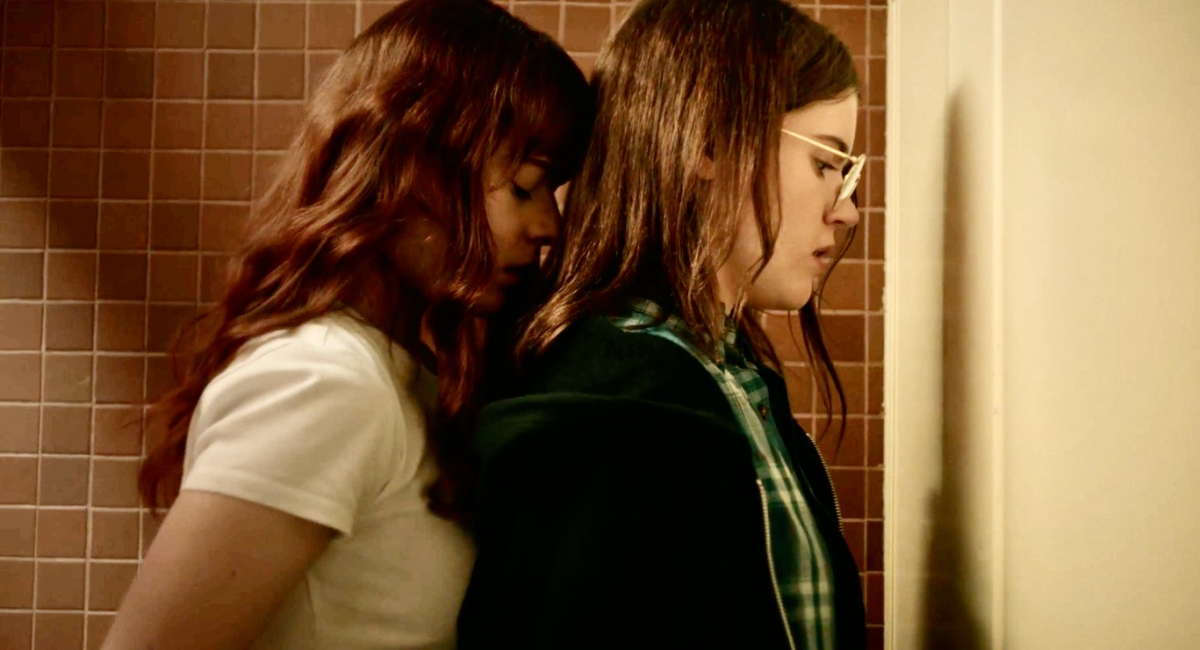
You Can Live Forever
It's almost impossible to imagine that there was once a time when every other TV series or film didn't feature at least one lesbian character in a positive light. Some now are even superheroes (Maeve in The Boys) who just might save the world.
But features, especially those both written and directed by lesbians have been far and in between, and when these films arrived, they seldom received the attention and the outlets they deserved. Some early pioneers who bucked the system included Chantal Akerman (Je Tu Il Elle (1974)), Cheryl Dunye (The Watermelon Woman (1996)), and Rose Troche (Go Fish (1994)). The latter inspired the highly illuminating 1998 essay by M. Dolores Herrero Granado with a title that tells all: "Go Fish: Resisting Silence and Invisibility and Coming Out as a Lesbian in a Post-Affirmation Era."
Well, now add Sarah Watts to this once sparcely membered grouping. Watts, a self-proclaimed Canadian lesbian who grew up in a Jehovah's Witness community, has noted: "As a teenager, I was eager to see a story with a character who even remotely resembled me on the movie screen, but I was always disappointed. When there were lesbian characters, they were inevitably used as plot points and usually died tragic deaths." Then she read about the Wachowskis' sultry Bound in a newspaper. Knowing she just had to view this film or else, she took the money she was saving for a European venture and flew instead to Vancouver to catch Bound (1996) on the big screen. If you've already seen this Jennifer-Tilly/Gina-Gershon starrer, you know it was worth twice that cost.
Now decades later Watts and her co-director/co-writer Mark Slutsky, both inspired by Watts' early life, have fashioned a resoundingly touching film, You Can Live Forever, that falls into that regular Romeo/Juliet coming-out mode that most LGBTQI coming-out stories adopt. Or maybe most love stories.
Two teen high schoolers meet, they fall into instant adoration, but society wants to pull them apart. Can two young women, who like kissing and fondling each other, fight the odds or will their love end like a dreaded Shakespearian tragedy. You pretty much know the answer even though the screenplay will keep you guessing.
The film begins in a train bathroom. Jamie Butley (a superb Anwen O'Driscoll) is standing on a lidless toilet, puffing on a blunt, and blowing the smoke into a ceiling vent. She's wearing a Siouxie and the Banshees T-shirt, wire-framed glasses, and jeans. Imagine a newbie lesbian. Well, the blunt is put away, and the train eventually stops at Gare Saguenay. Welcome to her new temporary home.
You see Dad just died, Mom has had a nervous breakdown of sorts, and Jamie’s been farmed out to her aunt who's a dyed-in-the-wool Jehovah's Witness.
Before we go on, here's some basic facts for those whose door has never been knocked upon by a Jehovah's Witness. According to a recent Pew Research Center poll, 76% of this religion's practitioners feel homosexuality should be discouraged, while only 16% state queer folk should be accepted. Imagine their views twenty years ago.
But not only is the same-sex act condemned, same-sex thought is demonized. As Janja Lalich and Karla McLaren note quite thoroughly in their 2010 article for the Journal of Homosexuality: "Jehovah's Witnesses condemns homosexual acts, thoughts, and feelings. Consequently, gay and lesbian Witnesses experience not just stigmatization and conflict between their sexual and religious identities in the social world, but also a nearly impossible task in their inner world."
Back to Jamie's new environs. Her aunt makes spaghetti, prayers are said over the table, then Jamie is forced to put on the plainest, most ill-fitting of dresses and attend an evening prayer gathering. Oh, no! How much tedium can a teen handle?
But then, while standing with the other attendees for some hymn singing, Jamie spots a back of an intriguing head of hair in the front row. That head of hair suddenly turns around and smiles. Meet the charming Marike (June Laporte).
Marike saddles up to Jamie after the service and invites her to a family dinner, which leads to sleepovers, and the "accidental" hand on breast while asleep. The two are soon inseparable, but can a believer and a nonbeliever ever get on the same footing?
When you watch the pair ogling each other over a dinner table with the innocent gooiness of first love, you have to say yes. Jamie and Marike have multiple "Tony/Maria-in-the-dancehall" moments where the girls block everyone else from their senses. You almost feel as if you are intruding and to be polite, you almost want to excuse yourself from the theater.
Here's a celebration of love trying to blossom in a world of enforced dullness. No video games. No birthday celebrations. And your mother is deemed dead and not to be spoken of if she leaves the community. Worst of all, families sit together and make believe they enjoy eating bowls of brightly green, lime Jell-o cubes.
So what's the timely film about? A love that must high jump over numerous religious blockades. With the beauty, warmth, and sort of naive intelligence of its two heroines, both finely embodied by LaPorte and O'Driscoll with the aid of a strong supporting cast, You Can Live Forever easily joins the ranks of the must-see LGBTQI films of the year.
(Hint #1 to ending: Just as Jamie enters her English class for the first time, her teacher is in the middle of the following line from Sonnet 116: "Love's not Time's fool, though rosy lips and cheeks . . . ."
Hint #2: The Cocteau Twins are letting loose with "Pitch the Baby" on Jamie's cassette player: "I'm so happy to care for you / I only want to love you.")
